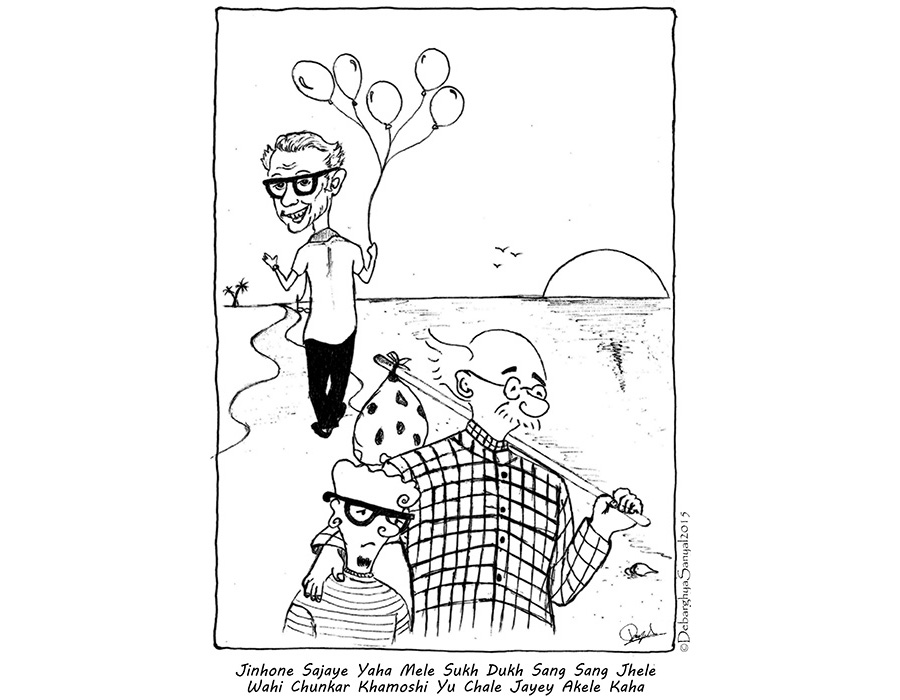Rasipuram Krishnaswami Laxman might have passed away, but the RK Laxman we know and love still stands with his potli, guarding our collective conscience, says Debarghya Sanyal.
Nineties. India. We were late at the party. By the time we arrived, most of the big guys had either checked out or were waiting for the cab back home. Kutty, Shankar and Vijayan were gone. Neelabh, Ninan, Suraiya and Tailang were the fresher lot; they would persist a little while longer. But by and large, all we could see were silhouettes, back profiles, and distant faces blurring away in the torrential influx of a whole different set of images—television serials, animated movies, video games.
Among all these receding and advancing images, however, there was this one chap in an old checked coat, frayed dhoti, ooljalool hair, and Gandhi-like (or, for a newer audience, Potter-like) spectacles, who was everywhere. Mostly by mistake and largely unrepentant. I was told his name was RK Laxman. And he would remain thus identified, this mute spectator old man in a dhoti, till 2005.
In 2005, at an inter-school talent show, a new old man would try taking up his mantle. No, I did not win anything. Nor was he on the stage giving away prizes. Rather, he sat in the front row, silently smiling or frowning through the performances, and left quite early. Only, curiously, people would keep pointing at this new old man and call him “RK Laxman”. The incident seemed so peculiar, it was easy to dismiss it as a misunderstanding, as a mistake made by 500-odd students and teachers. And that is exactly what I did. Years later, when on Republic Day 2015, they kept flashing the face of this new old man on TV, declaring with long sorrowful faces that “RK Laxman is no more.” I still dismiss it as a national mistake.
For me, Laxman was, and will remain, a myth—the golden king of a golden past. He reigned over the Indian populace at a time when our leadership was too busy with other, substantial chores, to get hurt and bleed curses at the minutest of pinpricks. This was before Ramjanmabhumi and Godhra, before the rise of the radical Right, before ‘terror’ became a socio-political phenomenon. This was when newspaper owners took notes from their editors and the advertisement guy was a silent clerk working away at one corner of the office. In this era, my Laxman, generally known today as the Common Man, could silently glide through scandalous parliamentary revelations, blasphemous backstage conversations and the greatest out-in-the-open secrets which everybody knew of but could never acknowledge.
There was no bypassing the Common Man’s silent gaze, he would be at the right place at the right time, holding a magnifying glass over the cracks and fissures in our body politic. He was the urban wayfarer peeking around drainage pipes and beggars, the rural peep happily spraying a banned pesticide. He would be there during Parliament proceedings, university protests, trade union rallies and drawing-room discussions. He was neither metropolitan nor small town, northern nor southern. He was the common man. A black-and-white, omnipresent image of humour and critique, which neither offered nor needed a definition, a categorisation, or an origin story.
Above all, however, what characterised him and his era was the lightness of humour itself. One would let float little bombs of hilarity and expect nothing more than little chuckles and wide smiles. It was all to keep people and their leaders grounded—to assert that to err is human, and our leaders, no matter how large their vote share was, weren’t gods but susceptible both to faults and to critique. It was a good way of keeping the house open to debates and discussions. Sitting pretty on the first page, you didn’t expect the pocket rockets to stir revolutions, topple governments or bring ideological shifts. You did not expect them to convert sinners into saints. No expectations, no fear. The necessity of being politically correct was much less arduous, much less oppressive and much less all-consuming than it is today. Cartoonists weren’t battling as many varied, contrasting image functions as they do today.
Today, we have an almost unreasonable abandon of images and information. And a wide variety of measures to quantify response and calculate ideas. Our jokers and jesters (read politicians and cartoonists/satirists/stand-up comics) have both become slaves to numbers—of shares, likes, tweets, TRPs, votes. They become tools for both garnering social identity as well as creating unwritten social codes that can go on to dictate opinions like never before. As we transcend from the text to the hypertext, both the critic and the criticised have become unprecedentedly embroiled within the process of opinion formation. Each new emerging episteme and issue is seamlessly gobbled up into the market of ideas, and resurrected time and again as opinion maker or opinion breaker, depending on the use and intention. At such a time one cannot, and must not, let anything go as simply light comic asides. Responsibilities have increased, so has intolerance for mistakes.
Eras end. One does not replicate them. We might mourn their passing, or we might not. The only things left behind are crumbling façades and fading legacies, which asymptotically tend to zero but there are always those few post-decimals which keep the apocalypse away. Rasipuram Krishnaswami Laxman, the little-known new old man, might have passed. But the RK Laxman we all know and love, still stands with his potli, one of the many (several of whom are new and upcoming) post decimals who stand gatekeeping our conscience. And that is hope enough. For it is in this ever decreasing space before complete annihilation that miracle, revolution, resurgence and rebirth happen.














